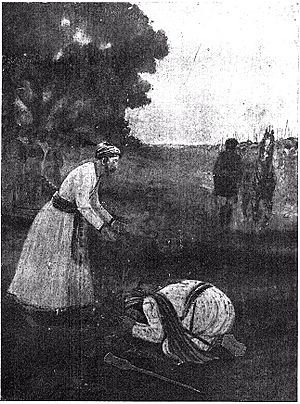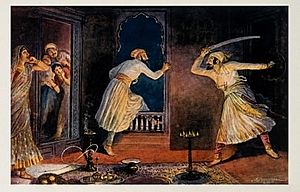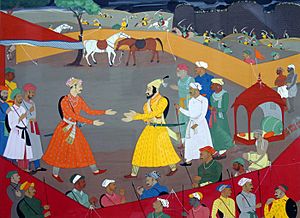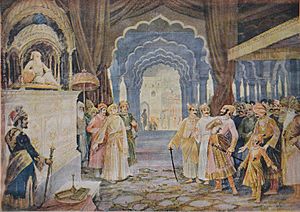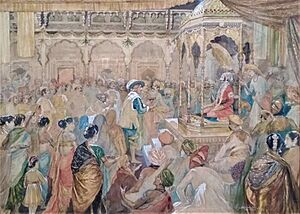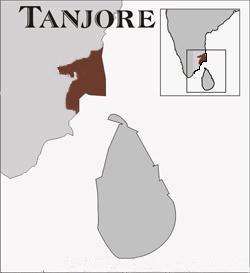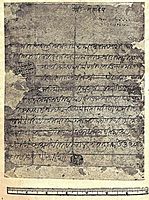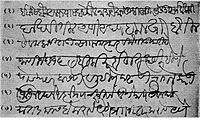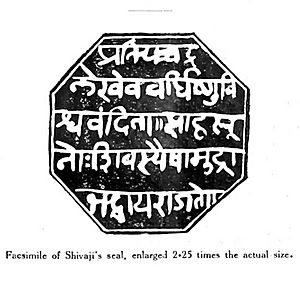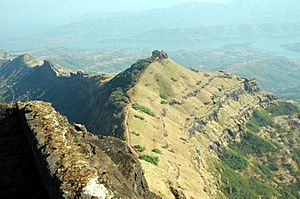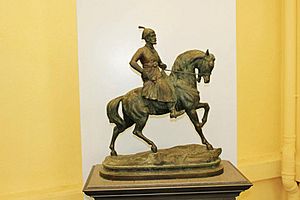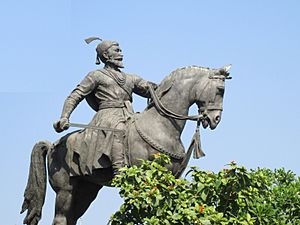Shivaji facts for kids
Quick facts for kids Shivaji I |
|
|---|---|
| Shakakarta Haindava Dharmoddharak |
|
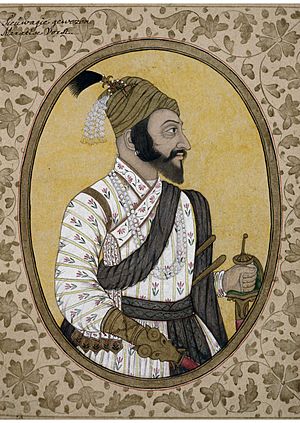
Portrait of Shivaji (c. 1680s), British Museum
|
|
| Reign | 1674–1680 |
| Coronation | 6 June 1674 (first) 24 September 1674 (second) |
| Predecessor | Position Established |
| Successor | Sambhaji |
| Peshwa | Moropant Trimbak Pingle |
| Born | 19 February 1630 Shivneri Fort, Ahmadnagar Sultanate (present-day Pune, Maharashtra, India) |
| Died | 3 April 1680 (aged 50) Raigad Fort, Mahad, Maratha Empire (present-day Maharashtra, India) |
| Spouse |
Sai Bhonsale
(m. 1640; d. 1659)Putalabai
(m. 1653)Sakvarbai
(m. 1656)
|
| Issue | 8 (including Sambhaji and Rajaram I) |
| House | Bhonsle |
| Father | Shahaji |
| Mother | Jijabai |
| Religion | Hinduism |
| Signature | |
Shivaji I (born c.19 February 1630 – died 3 April 1680), also known as Chhatrapati Shivaji Maharaj, was a great Indian ruler. He was part of the Bhonsle Maratha clan. Shivaji created his own independent kingdom from the weakening Adilshahi sultanate of Bijapur. This kingdom later grew into the powerful Maratha Empire. In 1674, he was officially crowned the Chhatrapati (meaning "sovereign" or "emperor") of his kingdom at Raigad Fort.
During his life, Shivaji formed alliances and also fought against the Mughal Empire, the Sultanate of Golkonda, the Sultanate of Bijapur, and the European powers. His army expanded the Maratha influence. They captured and built many forts. Shivaji also created a Maratha navy. He set up a fair and well-organized government. He brought back old Hindu traditions in his court. He also encouraged the use of Marathi and Sanskrit languages. These replaced Persian in his court and government.
Shivaji's importance grew nearly 200 years after his death. He became a hero for many Indian nationalists during the Indian independence movement. They saw him as a symbol of Hindu pride and a leader who fought for his people.
Contents
- Shivaji's Early Life
- Fighting the Bijapur Sultanate
- Fighting the Mughal Empire
- Recapturing Lands
- Becoming King: The Coronation
- Conquering Southern India
- Shivaji's Children
- Death and Who Ruled Next
- How Shivaji Governed
- Shivaji's Military Strategies
- The Maratha Empire After Shivaji
- Shivaji's Legacy and Remembrance
- See also
Shivaji's Early Life
Shivaji was born in the hill-fort of Shivneri. This fort is near the city of Junnar in what is now Pune district. There is some debate about his exact birth date. However, the Government of Maharashtra celebrates 19 February as a holiday for his birthday (Shivaji Jayanti). Shivaji was named after a local goddess, Shivai Devi.
Shivaji's father, Shahaji Bhonsle, was a Maratha general. He served different rulers in the Deccan Sultanates. His mother was Jijabai. She was the daughter of Lakhuji Jadhavrao, a powerful leader.
Shivaji's family, the Bhonsle clan, was well-known. His grandfather, Maloji, was an important general. He was given the title "Raja" and rights to collect taxes in areas like Pune. He also received Fort Shivneri for his family.
When Shivaji was born, three Islamic sultanates ruled the Deccan region. These were Bijapur, Ahmednagar, and Golkonda. Shahaji often changed his loyalty between these rulers and the Mughals. But he always kept his land in Pune and his small army.
Growing Up in Pune
In 1636, Shahaji joined the service of Bijapur. He was given Poona as a land grant. Shahaji was sent to Bangalore by the Bijapur ruler. He appointed Dadoji Kondadeo to manage Poona. Shivaji and Jijabai settled in Poona. Kondadeo was also in charge of training Shivaji in how to run the government.
Shivaji quickly learned physical skills like wrestling and horse riding. He was not very good at reading and writing. So, his ministers would read petitions and letters to him. Kondadeo died in 1647. After his death, Shivaji took over the administration. One of his first actions was to challenge the Bijapur government directly.
Fighting the Bijapur Sultanate
In 1646, when he was just 16, Shivaji captured Torna Fort. He took advantage of the confusion in the Bijapur court. The Sultan, Mohammed Adil Shah, was ill. Shivaji found a large treasure at Torna.
Over the next two years, Shivaji captured more important forts near Pune. These included Purandar, Kondhana, and Chakan. He also brought areas east of Pune under his control. He used the treasure from Torna to build a new fort called Rajgad. This fort became his government's main base for over ten years. After this, Shivaji moved west to the Konkan region. He took control of the important town of Kalyan.
The Bijapur government noticed these actions. On 25 July 1648, Shahaji was arrested by another Maratha leader. This was done on orders from Bijapur to stop Shivaji. Shahaji was released in 1649. This happened after the capture of Jinji helped Bijapur's position in Karnataka.
From 1649 to 1655, Shivaji paused his conquests. He quietly strengthened his control over the areas he had gained. After his father's release, Shivaji started raiding again. In 1656, he killed Chandrarao More, another Maratha leader loyal to Bijapur. He then took control of the valley of Javali. This allowed Shivaji to expand his raids into southern and southwestern Maharashtra.
Shahaji later distanced himself from his son's rebellious actions. He died around 1664–1665 in a hunting accident.
Battle with Afzal Khan
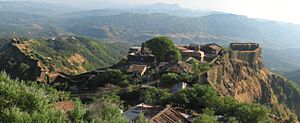
The Bijapur sultanate was unhappy about losing land to Shivaji. In 1657, the Sultan sent Afzal Khan, a skilled general, to capture Shivaji. Before meeting Shivaji, Bijapur forces damaged the Tulja Bhavani Temple. This temple was holy to Shivaji's family. They also damaged the Vithoba temple at Pandharpur, a major Hindu pilgrimage site.
Shivaji retreated to Pratapgad fort. Many of his allies urged him to surrender. The two armies were stuck. Shivaji could not break the siege. Afzal Khan had strong cavalry but no siege equipment to take the fort. After two months, Afzal Khan suggested they meet in private outside the fort.
They met in a hut at the foothills of Pratapgad fort on 10 November 1659. They agreed to come armed only with a sword and one follower. Shivaji suspected Afzal Khan would try to arrest or attack him. So, he wore armor under his clothes. He also hid a bagh nakh (metal "tiger claw") on his left arm and had a dagger. What exactly happened is not fully clear. But both sides agree that a fight broke out, and Afzal Khan was killed.
In the Battle of Pratapgarh on 10 November 1659, Shivaji's forces won a major victory. More than 3,000 Bijapur soldiers were killed. Many high-ranking officers and Afzal Khan's sons were captured. After the victory, Shivaji held a grand review. The captured enemy soldiers were set free and sent home with gifts. Maratha soldiers were rewarded for their bravery.
Siege of Panhala Fort
After defeating Bijapur, Shivaji's army marched into the Konkan region and Kolhapur. They captured Panhala fort. They also defeated Bijapur forces led by Rustam Zaman and Fazl Khan in 1659. In 1660, Adilshah sent his general Siddi Jauhar to attack Shivaji. The Mughals also planned to attack from the north.
Shivaji was at Panhala fort with his forces. Siddi Jauhar's army surrounded Panhala in mid-1660. They cut off all supplies to the fort. During the attack, Siddi Jauhar bought grenades from the English at Rajapur. He also hired English artillerymen. This made Shivaji angry. In December, he attacked the English trading post at Rajapur. He captured four English traders and held them until mid-1663.
After months of siege, Shivaji made a deal with Siddi Jauhar. He handed over the fort on 22 September 1660. Shivaji then moved to Vishalgad. He later recaptured Panhala in 1673.
The Battle of Pavan Khind
Shivaji escaped from Panhala under the cover of night. Enemy cavalry chased him. His Maratha leader, Baji Prabhu Deshpande, volunteered to fight to the death. He and 300 soldiers held back the enemy at Ghod Khind ("horse ravine"). This gave Shivaji and the rest of the army time to reach Vishalgad fort safely.
In the Battle of Pavan Khind, the smaller Maratha force held off the larger enemy. Baji Prabhu Deshpande was wounded. But he kept fighting until he heard cannon fire from Vishalgad. This signal meant Shivaji had reached the fort safely on 13 July 1660. Ghod Khind was later renamed Paavan Khind ("sacred pass"). This was to honor Baji Prabhu Deshpande and all the soldiers who fought there.
Fighting the Mughal Empire
Until 1657, Shivaji had peaceful relations with the Mughal Empire. He even offered to help Aurangzeb, the Mughal viceroy, conquer Bijapur. In return, he wanted official recognition of his forts and villages. But Shivaji was not happy with the Mughal response. He received a better offer from Bijapur. So, he launched a raid into Mughal territory.
Shivaji's first fights with the Mughals began in March 1657. Two of his officers raided Mughal land near Ahmednagar. Then, Shivaji raided Junnar. He took a lot of money and horses. Aurangzeb sent Nasiri Khan, who defeated Shivaji's forces at Ahmednagar. However, Aurangzeb's plans against Shivaji were stopped by the rainy season. He also had to fight his brothers for the Mughal throne. This happened after Emperor Shah Jahan became ill.
Attacks on Shaista Khan and Surat
Aurangzeb became the Mughal emperor. He sent his uncle, Shaista Khan, with a huge army of over 150,000 soldiers. They also had powerful artillery. In January 1660, they attacked Shivaji. Shaista Khan's well-equipped army seized Pune. He also took the nearby fort of Chakan. He besieged it for a month and a half before breaking its walls. Shaista Khan moved into Shivaji's palace, Lal Mahal, in Pune.
On the night of 5 April 1663, Shivaji led a daring surprise attack. He and 400 men attacked Shaista Khan's camp. They broke into Khan's bedroom and wounded him. Shaista Khan's son, some of his wives, and soldiers were killed. Khan then fled. Aurangzeb punished him for this embarrassment by transferring him to Bengal.
To get back at Shaista Khan and refill his treasury, Shivaji attacked the port city of Surat in 1664. Surat was a rich Mughal trading center. On 13 February 1665, he also launched a naval raid on Basrur in present-day Karnataka. He gained a lot of treasure from this raid.
The Treaty of Purandar
The attacks on Shaista Khan and Surat made Aurangzeb furious. He sent his Rajput general, Mirza Raja Jai Singh I, with an army of about 15,000 soldiers to defeat Shivaji. Throughout 1665, Jai Singh's forces pushed Shivaji hard. Their cavalry destroyed the countryside. Their siege forces surrounded Shivaji's forts.
The Mughal commander managed to convince several of Shivaji's key leaders to join the Mughal army. By mid-1665, the fort at Purandar was surrounded and almost captured. Shivaji had no choice but to make peace with Jai Singh.
In the Treaty of Purandar, signed on 11 June 1665, Shivaji agreed to give up 23 of his forts. He kept 12 forts for himself. He also agreed to pay 400,000 gold coins to the Mughals. Shivaji became a vassal of the Mughal empire. He also agreed to send his son Sambhaji with 5,000 horsemen to fight for the Mughals.
Arrest and Escape from Agra
In 1666, Aurangzeb called Shivaji to Agra. Shivaji went with his nine-year-old son, Sambhaji. Aurangzeb planned to send Shivaji to Kandahar (now in Afghanistan). This was to strengthen the Mughal empire's border. However, in the court on 12 May 1666, Shivaji was made to stand with low-ranking nobles. These were men he had already defeated in battle.
Shivaji felt insulted and walked out of the court. He was then placed under house arrest. Ram Singh, Jai Singh's son, promised to keep Shivaji and his son safe. Shivaji's situation under house arrest was dangerous. Aurangzeb's court debated whether to kill him or keep him employed. Jai Singh tried to influence Aurangzeb's decision.
Meanwhile, Shivaji planned his escape. He sent most of his men home. He then pretended to be sick. He started sending out large baskets of sweets. These were supposedly for Brahmins and the poor as a religious offering. On 17 August 1666, Shivaji hid himself in one large basket. His son Sambhaji hid in another. They escaped and left Agra.
Peace with the Mughals
After Shivaji's escape, fighting with the Mughals calmed down. Mughal leader Jaswant Singh helped Shivaji and Aurangzeb discuss new peace ideas. Between 1666 and 1668, Aurangzeb gave Shivaji the title of Raja. Sambhaji was also given back his rank in the Mughal army. Shivaji sent Sambhaji with General Prataprao Gujar to serve the Mughal viceroy in Aurangabad. Sambhaji also received land in Berar for collecting taxes.
Aurangzeb also allowed Shivaji to attack the weakening Adil Shahi kingdom. The Sultan, Ali Adil Shah II, asked for peace. He granted Shivaji the right to collect special taxes called sardeshmukhi and chauthai.
Recapturing Lands

The peace between Shivaji and the Mughals lasted until 1670. At that time, Aurangzeb became suspicious of Shivaji and Prince Mu'azzam. He thought they might be too close. Also, Aurangzeb reduced his army in the Deccan. Many disbanded soldiers quickly joined Shivaji's army. The Mughals also took back land from Shivaji. In response, Shivaji launched an attack against the Mughals. He recovered most of the lands he had given up in just four months.
Shivaji attacked Surat a second time in 1670. The English and Dutch trading posts managed to defend themselves. But Shivaji still managed to plunder the city. He took goods from a Muslim prince returning from Mecca. The Mughals were angry. They sent a force under Daud Khan to stop Shivaji. But Shivaji defeated them in the Battle of Vani-Dindori near Nashik.
In October 1670, Shivaji sent his forces to bother the English in Bombay. They had refused to sell him war supplies. So, his forces blocked English woodcutting parties. In September 1671, Shivaji sent an ambassador to Bombay. He again asked for war supplies. The English were worried about Shivaji's growing power. But they also wanted compensation for his looting their trading posts. Negotiations failed over the issue of compensation. Many envoys were exchanged over the years. Some agreements were made about arms in 1674. But Shivaji never paid the compensation before his death.
Battles of Umrani and Nesari
In 1674, Prataprao Gujar, the Maratha army chief, was sent to fight a Bijapur army. This army was led by General Bahlol Khan. Prataprao's forces defeated and captured Bahlol Khan. They cut off his water supply by surrounding a lake. This forced Bahlol Khan to ask for peace.
Shivaji had specifically warned Prataprao not to release Bahlol Khan. But Prataprao did so anyway. Bahlol Khan then started preparing for a new invasion. Shivaji sent an angry letter to Prataprao. He refused to see him until Bahlol Khan was recaptured. Upset by this rebuke, Prataprao found Bahlol Khan. He charged at him with only six other horsemen, leaving his main force behind. Prataprao was killed in the fight.
Shivaji was very sad to hear of Prataprao's death. He arranged for his second son, Rajaram, to marry Prataprao's daughter. Hambirrao Mohite became the new commander-in-chief. Raigad Fort was newly built by Hiroji Indulkar as the capital of the new Maratha kingdom.
Becoming King: The Coronation
Shivaji had gained a lot of land and wealth. But he did not have a formal title. He was technically still a Mughal tax collector or the son of a Bijapur landholder. He had no legal right to rule his lands. Becoming a king would fix this. It would also stop other Maratha leaders from challenging him. A Hindu king would also be important for the Hindu Marathas in a region mostly ruled by Muslims.
Preparations for the coronation began in 1673. But there were delays. The Brahmins (priests) in Shivaji's court refused to crown him. They said that only those from the kshatriya (warrior) varna could be kings. Shivaji came from a family of village headmen. So, the Brahmins considered him to be of the shudra (farmer) varna. They also noted that Shivaji had never had a sacred thread ceremony, which a kshatriya would.
Shivaji called Gaga Bhatt, a scholar from Varanasi. He claimed to find a family tree proving Shivaji was descended from the Sisodias. This meant Shivaji was indeed a kshatriya. To confirm this, Shivaji had a sacred thread ceremony. He also remarried his wives using the Vedic rites expected of a kshatriya.
On 28 May, Shivaji performed penance for not following Kshatriya rites. Then, Gaga Bhatt gave him the sacred thread. Shivaji also made up for any sins he had committed. He was weighed against seven metals like gold and silver. He was also weighed against other items like linen and sugar. All these items and a large sum of money were given to the Brahmins. Some Brahmins said Shivaji had caused the death of Brahmins, cows, women, and children during his raids. They said he could be cleansed of this sin for a price, which Shivaji paid. The total cost for the ceremonies was very high.
Shivaji was crowned king of the Maratha Empire on 6 June 1674 at Raigad fort. Gaga Bhatt led the ceremony. He poured water from sacred rivers over Shivaji's head. He also chanted Vedic mantras. About fifty thousand people gathered for the ceremonies. Shivaji was given the titles Shakakarta ("founder of an era") and Chhatrapati ("sovereign"). He also took the title Haindava Dharmodhhaarak (protector of the Hindu faith).
Shivaji's mother, Jijabai, died on 18 June 1674. Another ceremony was held on 24 September 1674. This was to satisfy those who still doubted Shivaji's right to the Vedic rites.
Conquering Southern India
Starting in 1674, the Marathas began an aggressive campaign. They raided Khandesh in October. They captured Bijapuri Ponda in April 1675. They also took Karwar and Kolhapur. In November, the Maratha navy fought the Siddis of Janjira. But they could not remove them. After recovering from an illness, Shivaji raided Athani in April 1676. He took advantage of a civil war in Bijapur.
Before his expedition, Shivaji appealed to a sense of Southern Indian patriotism. He said Southern India should be protected from outsiders. His appeal worked somewhat. In 1677, Shivaji visited Hyderabad for a month. He made a treaty with the Qutubshah of Golkonda. They agreed to reject Bijapur and fight the Mughals together. In 1677, Shivaji invaded Karnataka. He had 30,000 cavalry and 40,000 infantry. Golkonda helped with artillery and money. Shivaji seized the forts of Vellore and Gingee. Gingee later became a capital for the Marathas under his son Rajaram I.
Shivaji wanted to make peace with his half-brother Venkoji (Ekoji I). Venkoji ruled Thanjavur after their father Shahaji. The talks did not go well. So, on his way back to Raigad, Shivaji defeated his half-brother's army. He seized most of his lands in the Mysore plateau. Venkoji's wife, Dipa Bai, whom Shivaji respected, started new talks. She also convinced her husband to distance himself from Muslim advisors. In the end, Shivaji gave many of the seized properties to her and her female descendants. Venkoji agreed to conditions for managing the territories and maintaining Shahaji's memorial.
Shivaji's Children
| Name | Mother | Lifespan |
|---|---|---|
| Sakhubai Nimbalkar | Sai Bhonsale | 1651 - Unknown |
| Ranubai Jadhav | 1653 - Unknown | |
| Ambikabai Mahadik | 1655 - Unknown | |
| Sambhaji I | 14 May 1657 - 11 March 1689 | |
| Deepabai | Soyarabai | Unknown |
| Rajaram I | 24 February 1670 - 3 March 1700 | |
| Kamlabai | Sakvarbai | Unknown |
Death and Who Ruled Next
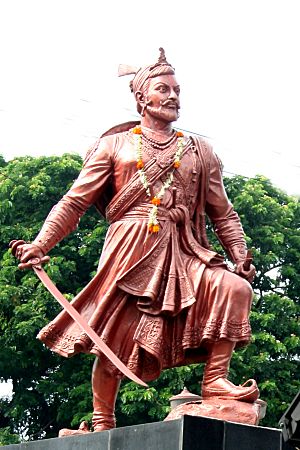
The question of who would rule after Shivaji was complicated. Shivaji had confined his son Sambhaji in 1678. But Sambhaji escaped with his wife and joined the Mughals for a year. Sambhaji then returned home and was again confined.
Shivaji died around 3–5 April 1680, at the age of 50. The exact cause of his death is debated. Some records say he died of a stomach illness. Others suggest anthrax. One biography mentions fever. Putalabai, Shivaji's childless eldest wife, performed sati by jumping into his funeral pyre. Another wife, Sakwarbai, was not allowed to do so because she had a young daughter. There were also rumors that his second wife Soyarabai had poisoned him. This was supposedly to make her 10-year-old son Rajaram king. However, later scholars doubt these claims.
After Shivaji's death, Soyarabai planned with ministers to crown her son Rajaram. She wanted him to rule instead of her stepson Sambhaji. On 21 April 1680, ten-year-old Rajaram was made king. However, Sambhaji took control of Raigad Fort. He killed the commander there. On 18 June, he gained control of Raigad. He officially became king on 20 July. Rajaram, his wife, and mother were imprisoned. Soyrabai was executed in October for conspiracy.
How Shivaji Governed
Council of Eight Ministers
Shivaji set up a special council called the Ashta Pradhan Mandal. This was a group of eight ministers. They regularly advised Shivaji on government matters.
| Minister | Duty |
|---|---|
| Peshwa or Prime Minister | General Administration |
| Amatya or Finance Minister | Keeping Public Accounts |
| Mantri or Chronicler | Keeping Court Records |
| Summant or Dabir or Foreign Secretary | Handling relations with other states |
| Sachiv or Shurn Nawis or Home Secretary | Managing the king's letters |
| Panditrao or Ecclesiastical Head | Religious matters |
| Nyayadhis or Chief Justice | Dealing with Civil and Military justice |
| Senapati/Sari Naubat or Commander-in-Chief | All matters related to the army |
Most ministers also held military commands. Their civil duties were often done by assistants.
Promoting Marathi and Sanskrit
In his court, Shivaji changed the official language from Persian to Marathi. Persian was common in other courts. Shivaji focused on Hindu political traditions. His rule helped Marathi become a language for detailed descriptions. Shivaji's royal seal was in Sanskrit.
Shivaji asked one of his officials to create a dictionary. This dictionary would replace Persian and Arabic words with Sanskrit ones. This led to the creation of ‘Rājavyavahārakośa’ in 1677. It was a thesaurus for state use.
Religious Tolerance
Shivaji was known for his fair and accepting religious policies. Hindus were happy to practice their religion freely under a Hindu ruler. Shivaji also allowed Muslims to practice their faith without trouble. He even supported Muslim religious leaders with gifts.
When Aurangzeb introduced the Jizya tax on non-Muslims in 1679, Shivaji wrote a strong letter. He criticized Aurangzeb's tax policy. During the attack on Surat in 1664, a monk asked Shivaji to spare the city's Christians. Shivaji left the Christians unharmed. He said, "the Frankish Padrys are good men."
Shivaji did not try to create a single Hindu rule. He was tolerant of different religions. He believed in mixing different beliefs. He urged Aurangzeb to respect Hindu beliefs and places, like Emperor Akbar did. Shivaji easily formed alliances with Muslim nations, even against Hindu powers. He also did not join other Hindu powers to fight the Mughals. His army had Muslim leaders early on. His naval admiral, Darya Sarang, was a Muslim.
Shivaji's Royal Seal
Seals were used to prove that official documents were real. Shahaji and Jijabai had Persian seals. But Shivaji, from the very beginning, used Sanskrit for his seal. The seal proudly states: "This seal of Shiva, son of Shah, shines forth for the welfare of the people and is meant to command increasing respect from the universe like the first phase of the moon."
Shivaji's Military Strategies
Shivaji kept a small but effective standing army. His main soldiers were farmers from the Maratha and Kunbi castes. Shivaji knew his army had limits. He realized that normal fighting methods would not work against the large, well-trained Mughal cavalry. The Mughals also had strong artillery.
So, Shivaji used guerilla tactics, known as 'Ganimi Kawa'. Shivaji was a master of this type of warfare. His strategies often confused and defeated the armies sent against him. He knew that large, slow armies had a weak point: their supplies. He used his knowledge of the local land and his fast cavalry to cut off enemy supplies. Shivaji avoided direct, open battles. Instead, he lured enemies into difficult hills and jungles he knew well. This caught them off guard and led to their defeat. Shivaji did not stick to one tactic. He used sudden raids, sweeps, ambushes, and psychological pressure as needed.
Aurangzeb and his generals called Shivaji a "Mountain Rat." This was because of his guerilla tactics. He would attack enemy forces and then quickly retreat into his mountain forts.
Shivaji was very skilled at organizing his military. His system lasted until the end of the Maratha Empire. His strategy relied on his ground forces, naval forces, and a network of forts. The Maval infantry formed the core of his ground forces. They were supported by Maratha cavalry. His artillery was not very strong and depended on European suppliers. This made him prefer fast, mobile warfare.
The Importance of Hill Forts
Hill forts were very important in Shivaji's strategy. He captured key forts like Murambdev (Rajgad), Torna, Kondhana (Sinhagad), and Purandar. He also rebuilt or repaired many forts in good locations. Shivaji built many new forts too. Some say he built 111, but the actual number was likely around 18. The historian Jadunath Sarkar estimated Shivaji owned about 240–280 forts when he died. Each fort had three officers of equal rank. This was to prevent any single officer from betraying the fort to the enemy. The officers worked together and kept each other in check.
Shivaji knew he needed a navy to control the Konkan coast. He started building his navy in 1657 or 1659. He bought twenty small ships from Portuguese shipyards. Maratha records say his fleet had about 400 warships at its peak. But English records say the number was never more than 160. Kanhoji Angre was the chief of the Maratha Navy.
The Marathas were used to land-based fighting. So, Shivaji looked for skilled crews for his ships. He hired lower-caste Hindus from the coast who knew a lot about naval operations. He also hired Muslim fighters. Shivaji noticed the power of the Portuguese navy. So, he hired Portuguese sailors and Goan Christian converts. He made Rui Leitao Viegas commander of his fleet. However, Viegas later went back to the Portuguese, taking 300 sailors with him.
Shivaji strengthened his coastline by capturing and repairing coastal forts. He built his first sea fort at Sindhudurg. This became the main base for the Maratha navy. His navy was a coastal navy. It focused on travel and fighting close to the shore. It was not meant to go far out into the open sea.
The Maratha Empire After Shivaji
Shivaji left behind a state that was always fighting the Mughals. Soon after his death, in 1681, Aurangzeb launched a big attack in the South. He wanted to capture lands held by the Marathas, Bijapur, and Golkonda. He succeeded in destroying the Sultanates. But he could not defeat the Marathas, even after spending 27 years in the Deccan.
During this time, Sambhaji was captured and executed in 1689. The Marathas fought back strongly. They were led by Sambhaji's successor, Rajaram, and then by Rajaram's widow, Tarabai. Lands changed hands many times between the Mughals and the Marathas. The conflict ended in defeat for the Mughals in 1707.
Shahu, Shivaji's grandson and Sambhaji's son, was held prisoner by Aurangzeb for 27 years. After Aurangzeb's death, his successor released Shahu. After a short power struggle with his aunt Tarabai, Shahu ruled the Maratha Empire from 1707 to 1749. Early in his rule, he appointed Balaji Vishwanath and later his family members as Peshwas (prime ministers).
The empire grew greatly under Balaji's son, Peshwa Bajirao I, and grandson, Peshwa Balaji Bajirao. At its largest, the Maratha empire stretched from Tamil Nadu in the south to Peshawar (modern-day Khyber Pakhtunkhwa) in the north, and Bengal in the east. In 1761, the Maratha army lost the Third Battle of Panipat to Ahmed Shah Abdali of Afghanistan. This stopped their expansion in northwestern India. Ten years later, Marathas regained influence in North India.
To manage the large empire, Shahu and the Peshwas gave some freedom to their strongest knights. This created the Maratha Confederacy. These knights became known as the Gaekwads of Baroda, the Holkars of Indore, the Scindias of Gwalior, and the Bhonsales of Nagpur. In 1775, the East India Company got involved in a power struggle in Pune. This led to the First Anglo-Maratha War. The Marathas remained the main power in India until they were defeated by the British in the Second and Third Anglo-Maratha wars (1805–1818). After these wars, the British East India Company became the main power in most of India.
Shivaji's Legacy and Remembrance
Shivaji was known for his strong religious and warrior code of ethics. He was seen as a national hero during the Indian Independence Movement. Some stories say he was greatly influenced by the Brahmin guru Samarth Ramdas. Others say Ramdas's role has been exaggerated by later Brahmin writers.
How People Saw Shivaji
Writers from England, France, the Netherlands, Portugal, and Italy admired Shivaji. They wrote about his heroic actions and clever plans. English writers compared him to great leaders like Alexander, Hannibal, and Julius Caesar.
Mughal writings about Shivaji were mostly negative. They called him "Shiva" without the respectful "-ji." One Mughal writer in the early 1700s described Shivaji's death as "the infidel went to Hell."
Shivaji's Image Over Time
In the mid-1800s, a social reformer named Jyotirao Phule wrote about Shivaji. He showed Shivaji as a hero for the lower classes. Phule wanted to use Shivaji's story to challenge the Brahmins. He said they had taken over the story. His 1869 ballad about Shivaji was not well-received by Brahmin-led media.
Later, in the late 1800s, non-Brahmin thinkers in Bombay used Shivaji's memory. They saw themselves as his descendants. They claimed the kshatriya (warrior) varna through him. Some Brahmins disagreed. But others saw that the Marathas were useful for the Indian independence movement. So, they supported this idea of Shivaji's kshatriya heritage.
In 1895, Indian nationalist leader Lokmanya Tilak started an annual festival for Shivaji's birthday. He presented Shivaji as someone who fought against oppressors. Tilak said his festival was not anti-Muslim or disloyal to the government. It was simply a celebration of a hero.
One of the first people to change the critical British view of Shivaji was M. G. Ranade. His book Rise of the Maratha Power (1900) said Shivaji's achievements were the start of modern nation-building. Ranade criticized earlier British descriptions of Shivaji's state. He said they wrongly called it a "freebooting Power, which thrived by plunder."
In 1919, Sarkar published Shivaji and His Times. This book was seen as the most reliable biography of the king. Sarkar could read old sources in Persian, Marathi, and Arabic. But he was criticized for his views on Marathi historians.
Remembering Shivaji Today
Shivaji is remembered all over India, especially in Maharashtra. Statues and monuments of Shivaji are found in almost every town and city in Maharashtra. They are also in many other places across India. Other ways he is remembered include the Indian Navy's station INS Shivaji. Many postage stamps feature him. The main airport and railway headquarters in Mumbai are also named after him. In Maharashtra, children have a long tradition of building replica forts with toy soldiers during the Diwali festival. This is done in memory of Shivaji.
A plan to build a huge memorial called Shiv Smarak was approved in 2016. It will be on a small island in the Arabian Sea near Mumbai. It will be 210 meters tall. This would make it one of the world's largest statues when finished. In March 2022, a statue made of gunmetal was opened in Pune.
See also
 In Spanish: Shivaji para niños
In Spanish: Shivaji para niños


